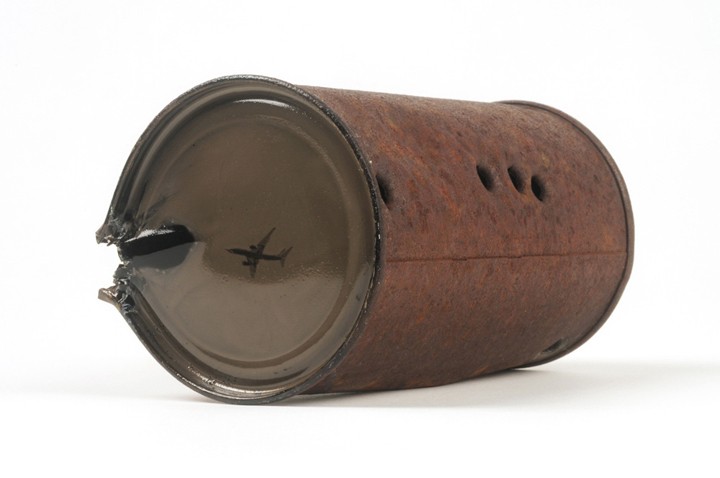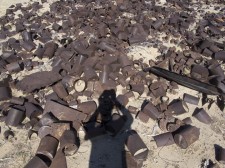
David Emitt Adams
American, 1980
Airplane Heading West of the Sonoran Desert, 2012
tintype on found object from the Sonoran Desert
4 3/4 x 2 3/4 x 2 3/4 in.

Undated photo of Adams

Shadow portrait of Adams with trash in desert
COMMENTS
David Emitt Adams is an emerging photographer based in Tempe, Arizona. Born in Yuma, Arizona, he pursued a Bachelors of Fine Art degree from Bowling Green State University in Ohio and returned to Arizona for his Master of Fine Arts degree from Arizona State University.
David is gaining attention as an artist, whose current practice engages historical media and uses them in an informed contemporary dialogue about photography’s past and present. His work has been exhibited throughout the United States and abroad, including established institutions such as the SOHO Photo Gallery in New York City and The Studio in London, England. David was selected for the prestigious Lens Culture International Exposure Award 2011 and most recently, was awarded the Freestyle Crystal Apple Award for Outstanding Achievement in Black and White Photography. Within the last year, David was awarded the Nathan Cummings Foundation $5000 travel grant that funded a trip to France and England. This opportunity enabled him to investigate the resurgence of antiquated processes at its source and their application in contemporary photography. He has given artist lectures at the San Francisco Art Institute sponsored by PhotoAlliance as well as the Carnegie Museum of Art as part of the 2012 f295 Symposium. Currently he is working on two new bodies of work as an Artist-in-Residence at Art Intersection in Gilbert, Arizona.
Artist statement on Conversations with History
I was born in Yuma Arizona in 1980. By the time I was an adult the Arizona desert was far from that once documented by Timothy O’Sullivan. Never have I known this landscape without roads, homes, buildings or urban sprawl. This notion of land untouched by the hand of man is so foreign it might as well be make-believe. As long as people have been in the American West, we have found its barren desert landscapes to be an environment perfect for dumping and forgetting.
The deserts of the West also have special significance in the history of photography. I have explored this landscape with an awareness of the photographers who have come before me, and this awareness has led me to pay close attention to the traces left behind by others. For this body of work, I collect discarded cans from the desert floor, some over four decades old, which have earned a deep reddish-brown, rusty patina. This patina is the evidence of light and time, the two main components inherent in the very nature of photography. I use these objects to speak of human involvement with this landscape and create images on their surfaces through a labor-intensive 19th century photographic process known as wet-plate collodion. The result is an object that has history as an artifact and an image that ties it to its location. These cans are the relics of the advancement of our culture, and become sculptural support to what they have witnessed.
http://www.davidemittadams.com
SBMA CURATORIAL LABELS
A native of Arizona, DAVID EMITT ADAMS has had life-long experience of the American desert. But unlike the pristine landscape depicted in nineteenth-century survey photographs, Adams found the desert “to be an environment perfect for dumping and forgetting.”
Roaming through the Arizona landscape for the past many years, Adams paid particular attention to the detritus and traces left by humans. Carefully collecting rusty tin cans, some older than himself, the photographer looked for the visual evidence of light and time that results in the rich, rust-colored patina. Using these objects as his photographic base, Adams employs the same labor-intensive 19th century process – wet-plate collodion – as the early survey photographers such as Timothy O’Sullivan. His resulting objects are both artifact and photograph, the images reflecting the landscape in which the rusty cans were found.
Adams’s three-dimensional images offer a unique perspective on human interaction with the landscape, one that is at once jarring and at the same time intriguing.
- SBMA Label, 2013
